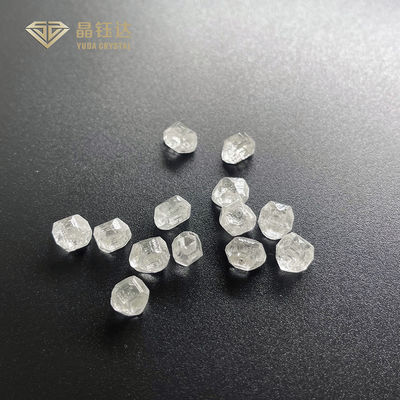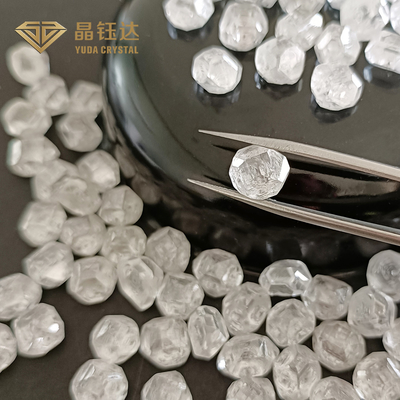2.0-2.5ct DEF Color VVS VS Clarity HPHT Rough Diamond For High Quality Lab Grown Diamonds Making
Lab Grown Rough Diamonds Description
The Lab Grown Diamonds are produced in the laboratory. The laboratory uses advanced technology and equipment to reduce the environment for the formation of natural diamonds. By using fine diamond seeds to induce natural diamond crystallization, Lab Grown Diamonds with the same physical, chemical and optical properties as natural diamond can be cultivated on the ground. So the Lab Grown Diamonds in the lab are real diamonds.
Lab Grown Diamonds are 100% real diamonds and 100% eco-friendly diamonds. It's very cost effective and more affordable.
What is CVD diamond?
CVD stands for "chemical vapor deposition" system.
The CVD system starts with diamond seed. Diamond seed is a kind of small natural diamond fragment which can withstand extreme temperature and pressure. In the process of chemical vapor deposition, the vacuum chamber where the diamond "seed" is located is filled with gases with high carbon content, and then heated to a high temperature much higher than 1000 degrees, and these gases are transformed into "plasma"
For those of us who don't know, plasma is to help "build" diamond layers and make them lovely gems. We know and love them very much.
What is HPHT diamond?
HPHT stands for high pressure and high temperature. In order to grow high performance high temperature diamond, a small diamond seed was put into carbon, that is element the diamond is made of diamond. Diamond seeds are exposed to extreme heat and pressure to replicate diamonds in a natural way. They grow underground. Diamond seeds exposed above 1100 degrees, pressure about 1.5 million Pounds per square inch. The carbon melts around the seeds and forms diamonds. Then it cools and the diamond forms.
Chemical vapor deposition (CVD) is a method to grow diamond from hydrocarbon gas mixture. The flexibility and simplicity of CVD devices explain the popularity of CVD growth in laboratory research. The advantages of CVD diamond growth include the ability to grow diamond on large area and different substrates, as well as the fine control of chemical impurities and properties of the diamond.
The growth of CVD involves the preparation of substrates, injecting different amounts of gases into a chamber and energizing them. The substrate preparation includes selecting suitable materials and crystal orientation; When cleaning, diamond powder is often used to grind non diamond substrate; Optimized substrate temperature (about 800 ℃) In the growth process, through a series of test run. These gases usually include a carbon source, usually methane, and a typical ratio of 1:99 hydrogen. Hydrogen is essential because it selectively corrodes non diamond carbon. These gases are ionized into chemically active radicals in the growth chamber by microwave power, hot filament, arc discharge, welding torch, laser, electron beam or other methods.
Parameters of Lab Grown Rough Diamonds
| HPHT Lab Grown Diamonds Details |
| Brand Name |
Yuda Crystal |
| Name |
Rough Lab Grown Diamonds |
| Diamond Color |
D-F |
| Diamond Clarity |
VVS-VS |
| Diamond Carat Weight |
2.0-2.5 carat |
| Diamond Cut |
Uncut |
| Technology |
HPHT |
| Size |
5-10mm |
| Shape |
Raw |
| Application |
For Cutting Lab Grown Loose Diamonds |
| Place Of Origin |
Zhengzhou, China |
| Delivery Time |
1 - 15 Working Days Base on Order Quantity |
| Payment Terms |
100% Payment In Advance |
| Payment Methods |
T/T, PayPal, Western Union, Bank Transfer |
| Shipping way |
DHL, FedEx, SF Express, UPS, EMS, TNT etc |
| M.O.Q |
Negotiable |
| Diamond Type |
Synthetic(lab created) |
| Location |
Zhengzhou, China |
| Treatments Applied |
None |
| Fire Dispersion |
0.044(Same as Natural Diamond) |
| Brilliance Refraction Index |
2.42(Same as Natural Diamond) |
| Relative Density |
3.52(Same as Natural Diamond) |
| Chemical Composition |
Carbon(Same as Natural Diamond) |
| Moh's Hardness |
10(Same as Natural Diamond) |
Lab Grown Rough Diamonds Introduction
HPHT is the abbreviation for high temperature and high pressure treatment, and its purpose is to change or improve the natural body color of certain types of diamonds to make them more valuable.
In the past, it was called Pegasus diamond and GE POL diamond. The reason why it is called GE Diamond is because The technology developed by GE in the United States is a new product exclusively sold by POL, a subsidiary of Israel's LKI, in 1999.
HPHT technology is to process natural diamonds at high temperature and high pressure to enhance the color grade of diamonds. In one move, it can be upgraded to 4-6 levels. However, not every diamond can be processed by this technology. It must have a J color or higher, and be free of impurities and high-clarity quality. During processing, the results cannot be predicted. In other words, it is not certain what level it can be promoted to.
At the same time, diamonds treated with HPHT may deepen or change in color to become a colored diamond.
Natural diamonds are created by nature and are the result of high temperature and pressure formed over billions of years. The Rough Lab Grown Diamonds are produced in the laboratory, usually in a few weeks. The chemical difference between the two is same.
So how do you distinguish between Rough Lab Grown Diamonds and natural diamonds?
There is no obvious difference between the Rough Lab Grown Diamonds and natural diamonds. Even professional gemologists need special equipment to identify them. By zooming in, professionals will be able to discern subtle contrasts in diamond inclusions grown and mined in the laboratory.
| The Difference Between Lab Diamond And Natural Diamond |
| Properties |
Earth Mined |
Lab Created |
| Guaranteed Conflict-Free |
No |
Yes |
| Hardness (MOHS) |
10 |
10 |
| SP3 Carbon Diamond Bonds (%) |
100% |
100% |
| Internal Crystal Structure |
Face-Centered Cubic |
Face-Centered Cubic |
| Hardness Comparable |
2.42 |
2.42 |
| Relative Diversity |
3.52 |
3.52 |
| Color Diffusion |
0.044 |
0.044 |
| Color |
Various Grades |
K to D grades |
| Price |
$$$$$ |
$$$ |
Lab Grown Rough Diamonds Details


 Your message must be between 20-3,000 characters!
Your message must be between 20-3,000 characters! Please check your E-mail!
Please check your E-mail!  Your message must be between 20-3,000 characters!
Your message must be between 20-3,000 characters! Please check your E-mail!
Please check your E-mail! 







